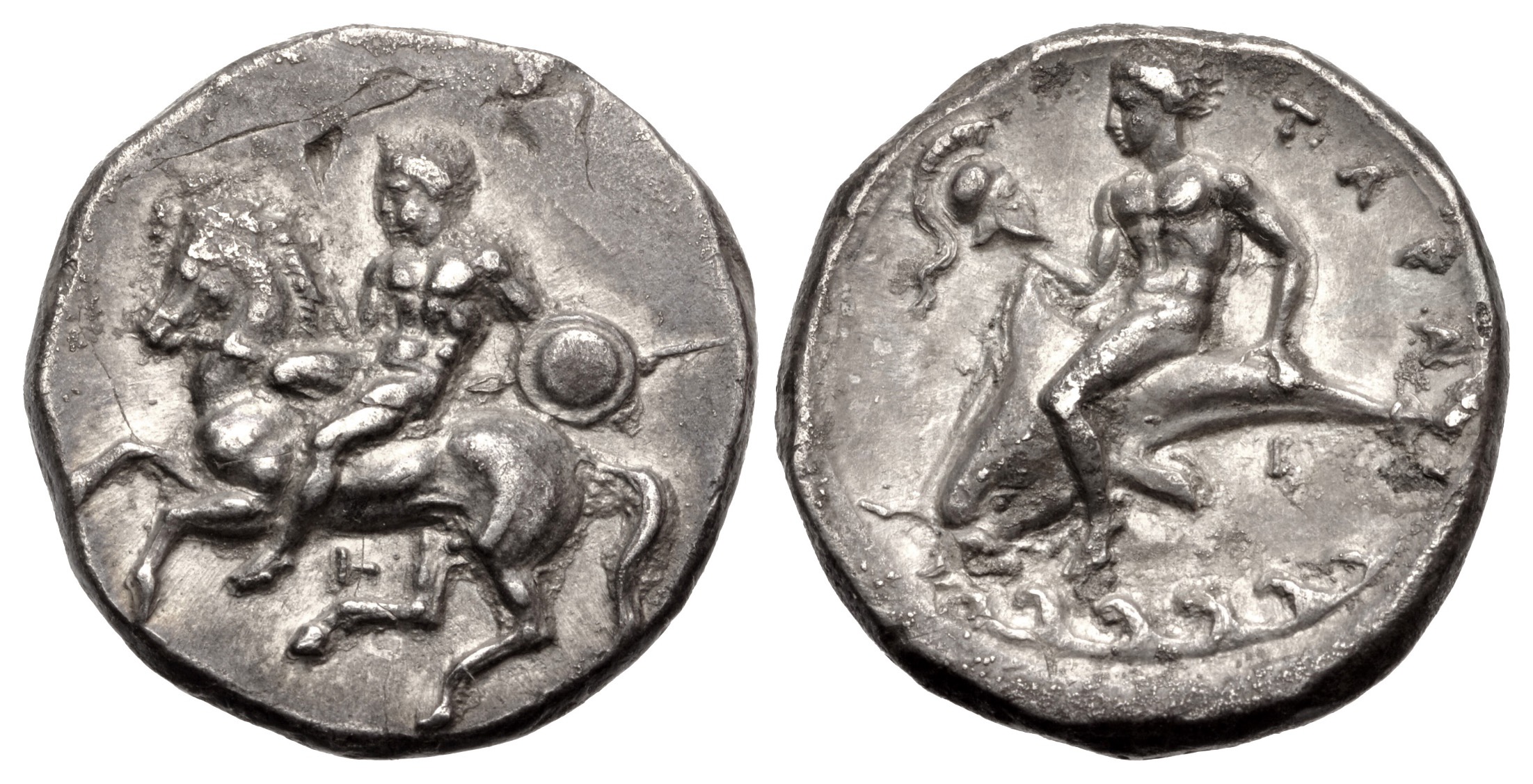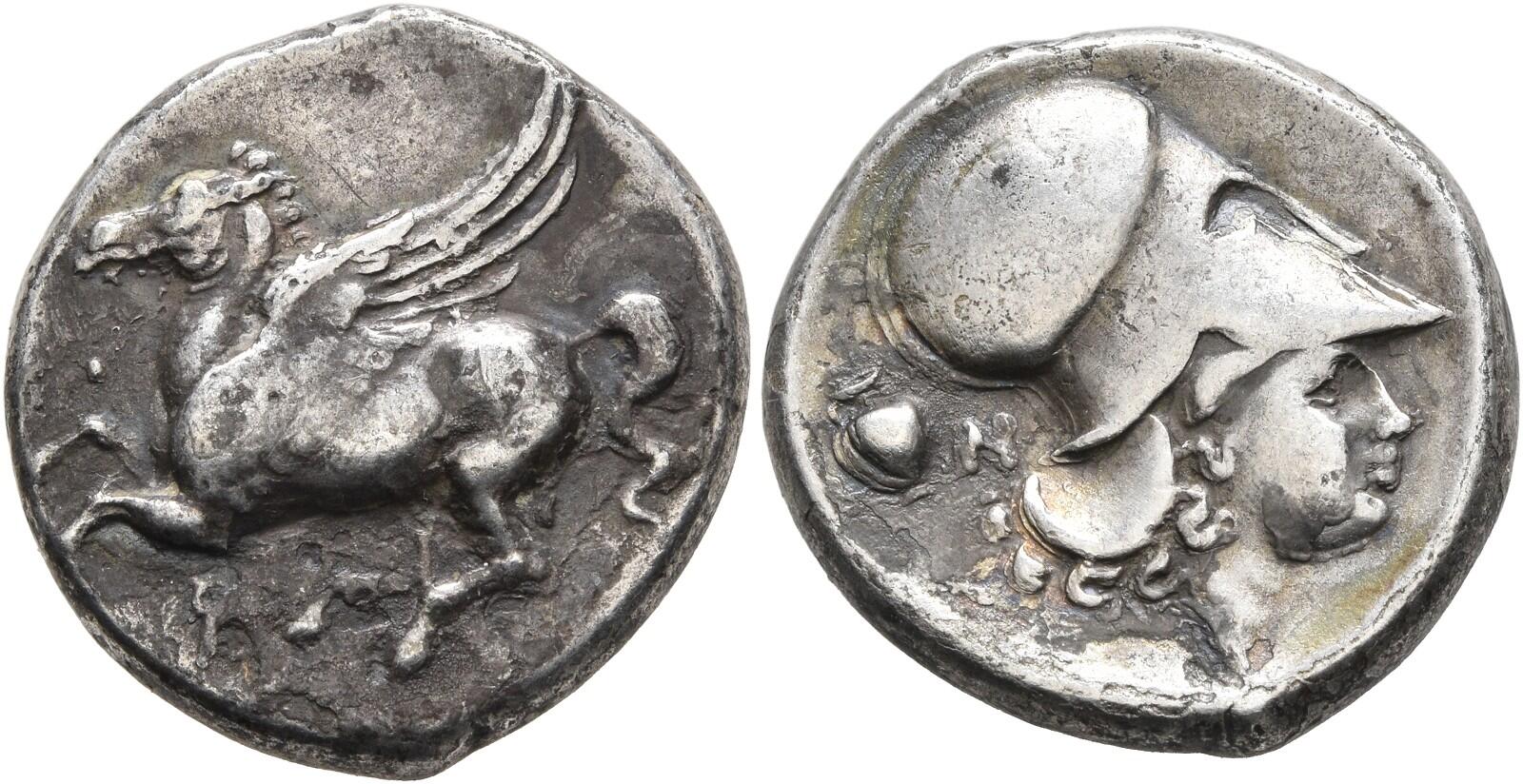346 BCE - 340 BCE | TAPAΣ
Overstriking coin
2432 - Taras (AR nomos) over uncertain type.jpg
[1]
Overstruck variety
Corinth (head r.).jpg
|
|
Sale(s)Sale(s) ᵖ:
|
Münzen und Medaillen, 40, 4 June 2014, 8 = CNG, EA 484, 27 Jan 2021, 7 ("Also includes an old Bank Leu stock ticket")
|
|
|
|
Description
| ObverseInscription or printing placed on the obverse.:
|
Warrior, nude, holding shield and spear, riding horse galloping left
|
ReverseInscription or printing placed on the reverse.:
|
TAPAΣ (Greek) Phalanthos, nude, holding trident over shoulder, riding dolphin left
|
Mint and issuing power
| MintIdentifies the place of manufacture or issue of a numismatic object.:
|
Taras
|
Ancient regionAncient region.
|
Calabria
|
Modern countryModern country: Italy
|
AuthorityIdentifies the issuing power. The authority can be "pretended" when the name or the portrait of X is on the coin but he/she was not the issuing power. It can also be "uncertain" when there is no mention of X on the coin but he/she was the issuing power according to the historical sources:
|
|
Chronology
| FromIdentifies the initial date in a range assigned in a numismatic context. 346 BCE toIdentifies the final date in a range assigned in a numismatic context.. 340 BCE
|
Classical 480-323 BC  periodTime period of the numismatic object. periodTime period of the numismatic object.
|
Physical description
MetalThe physical material (usually metal) from which an object is made.: Silver 
|
WeightWeight of the numismatic object (in grams). in grams: 7.417.41 g <br />7,410 mg <br />
|
DenominationTerm indicating the value of a numismatic object. Examples: tetradrachm, chalkous, denarius.: nomos
|
AxisDescribes the directional relationship between the obverse and reverse of a numismatic object.: 55 mm <br />0.5 cm <br />
|
| DiameterDescribes diameter of an object (in mm).: 2121 mm <br />2.1 cm <br />
|
|
References
| Coin referenceReference of the Coin:
|
|
Coin series referenceReference to coin series study:
|
Ravel 19471Ravel 1947, n° 440, SNG Lockett2SNG Lockett, n° 165 (same dies), Fischer-Bossert 19993Fischer-Bossert 1999, Group 47, n° 653 (V252/R505), Ravel 19471Ravel 1947, n° 440 (same obv. die), HN Italy4HN Italy, n° 876
|
| Coin series web referenceCoin series web references:
|
|
Description
| ObverseInscription or printing placed on the obverse.:
|
Pegasus flying
|
ReverseInscription or printing placed on the reverse.:
|
Head of Athena r.
|
Mint and issuing power
| MintIdentifies the place of manufacture or issue of a numismatic object. ᵖ:
|
Corinth
|
Ancient regionAncient region. ᵖ
|
Peloponnesus
|
Modern countryModern country: Greece
|
AuthorityIdentifies the authority in whose name (explicitly or implicitly) a numismatic object was issued. ᵖ:
|
|
Chronology
| FromIdentifies the initial date in a range assigned in a numismatic context. 400 BCE toIdentifies the final date in a range assigned in a numismatic context.. 340 BCE
|
Classical 480-323 BC  periodTime period of the numismatic object. periodTime period of the numismatic object.
|
Physical description
| DenominationTerm indicating the value of a numismatic object. Examples: tetradrachm, chalkous, denarius. ᵖ:
|
stater 
|
|
|
References
References
- a b Ravel, Oscar E. (1990), Descriptive catalogue of the collection of Tarentine coins formed by M. P. Vlasto, London, Spink
- ^ Mildord, H. (ed) (1938), Sylloge Nummorum Graecorum, Great Britain. Vol. 3 : The Lockett Collection, 5 parts, Oxford University Press.
- ^ Fischer-Bossert, Wolfgang (1999), Chronologie der Didrachmenprägung von Tarent, 510-280 v. Chr., Berlin, De Gruyter, xvii, 495 p., [84] pl.
- ^ Rutter N. Keith et alii (eds.) (2001), Historia Numorum Italy, London, xvi, 223 p., 43 pl.
- ^ Calciati, Romolo (1990), Pegasi, Mortara, Edizioni I.P..


